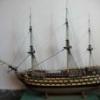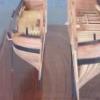Supplies of the Ship Modeler's Handbook are running out. Get your copy NOW before they are gone! Click on photo to order.
×
-
Posts
4,873 -
Joined
-
Last visited
Reputation Activity
-
 gjdale got a reaction from Eddie in 42ft Longboat Armed For War 1834 by BlockPlane - FINISHED - Scale 1:36
gjdale got a reaction from Eddie in 42ft Longboat Armed For War 1834 by BlockPlane - FINISHED - Scale 1:36
Liver of Sulphur is great for blackening Copper, but it will not work on Brass.
Another option for blackening Brass is Jax Pewter Black, which despite the name, works very well on Brass.
-
 gjdale reacted to RGL in IJN Yamato by RGL - FINISHED - Tamiya - 1/350 - PLASTIC
gjdale reacted to RGL in IJN Yamato by RGL - FINISHED - Tamiya - 1/350 - PLASTIC
The last of the support structures for the main superstructure are the 4 bases of the type 94 director and the navigation lights, including handrails, MG controller, the crew ready room. This is pretty much it and the convoluted mast will be next.
Dryfitting the assembly you can see how many vacant spots there are and how much piece work is to go.
-
 gjdale reacted to Roger Pellett in Mini Mill recommendations
gjdale reacted to Roger Pellett in Mini Mill recommendations
A "must" attachment for the Sherline mill is their Sensitive Drilling Attachment useful for drilling holes with very small wire sized drill bits. This is particularly useful for making blocks and deadeyes and essential if you don't have a drill press. I don't know if the other mills that you are considering can be used with such an attachment.
Regarding size of milling cutters. With the Sherline mill and the right collets you can always use the smaller mills (1/8in shank) but with the smaller mills you can't use the larger ones.
Roger
-
 gjdale got a reaction from Jack12477 in 42ft Longboat Armed For War 1834 by BlockPlane - FINISHED - Scale 1:36
gjdale got a reaction from Jack12477 in 42ft Longboat Armed For War 1834 by BlockPlane - FINISHED - Scale 1:36
Liver of Sulphur is great for blackening Copper, but it will not work on Brass.
Another option for blackening Brass is Jax Pewter Black, which despite the name, works very well on Brass.
-
 gjdale got a reaction from mtaylor in Mini Mill recommendations
gjdale got a reaction from mtaylor in Mini Mill recommendations
Tim,
For what it's worth, I'd encourage you to go with the Sherline. As my Dad always says, quality is remembered long after price is forgotten! You will never regret the extra expense of the initial outlay for the Sherline. And then of course, you'll never be saying "I wish I'd held off a little longer and bought the Sherline instead"......
-
 gjdale reacted to mobbsie in 1949 Chris-Craft 19' Racing Runabout by gjdale - FINISHED -Dumas - 1:8 Scale - RADIO
gjdale reacted to mobbsie in 1949 Chris-Craft 19' Racing Runabout by gjdale - FINISHED -Dumas - 1:8 Scale - RADIO
Hi Grant,
I'm intrigued to see how you develop the cutwater, I've never seen this before mate, looks interesting.
Good luck on getting the wheel centred, that's not going to be easy but I think I know how your going to tackle it. Just don't make it too complicated though, you know I don't do complicated !!!!!!!!!!!!!!!!!!!!!!!!
Watching with great interest my friend.
Be Good
mobbsie
-
 gjdale reacted to Mike Y in Beavers Prize 1777 by Mike Y - 1:48 - POF - Hahn style
gjdale reacted to Mike Y in Beavers Prize 1777 by Mike Y - 1:48 - POF - Hahn style
The log is not abandoned, just a very slow building due to an upcoming Christmas and everything related to it.
Notches lined up:
Whoopsie, forgot that wings are at an angle. Argh, redoing this piece again from scratch.
Two curved things are in place, one to go and then I can fair it nice and flush:
-
 gjdale got a reaction from Jack12477 in Schooner Polotsk 1777 by Mike Y and his daughter - Master Korabel - 1:72
gjdale got a reaction from Jack12477 in Schooner Polotsk 1777 by Mike Y and his daughter - Master Korabel - 1:72
Nice progress Daria - I see you've worked out how to use clamps properly and you are even starting to get the hang of using an airbrush! Keep up the great work.
-
 gjdale got a reaction from hamilton in 1949 Chris-Craft 19' Racing Runabout by gjdale - FINISHED -Dumas - 1:8 Scale - RADIO
gjdale got a reaction from hamilton in 1949 Chris-Craft 19' Racing Runabout by gjdale - FINISHED -Dumas - 1:8 Scale - RADIO
Many thanks as always for all the kind comments and the "likes". On with the show....
Of Moulds and Wheels
Before completing the finish on the hull, I decided to take a little diversion in two directions. Firstly, I decided that it would be a good time to make a mould of the bow so that I could work on the cutwater off the model (and hence protect that lovely surface). And secondly, I decided it was about time to start tackling the building of a new steering wheel.
To make a mould of the bow, I bought some plaster from the local art store. I could have gone all fancy and bought some very expensive mould making material, but as this is a one-off job, I decided to keep it simple and inexpensive. To create the mould, I mixed up some plaster and water and then suspended the boat above it by looping some brass wire through the rudder post, then attaching some rope hooked over the garage door tracks, and then lower the boat into the plaster. Of course, I had taken the precaution of wrapping the bow in cling wrap first!
Once the plaster had set, I removed the boat and coated the mould with some silicon grease to act as a release agent. Then I mixed up some more plaster and water and poured it into the mould. I also inserted two pieces of dowel to use as “handles” later on. In this picture, the cast has set and I have cut around the top edge prior to lifting out.
And here is the final product:
After this photo was taken, I cleaned up the cast with a light sanding and then painted it with a coat of finishing resin to (hopefully) prevent it from crumbling as I work with it. More on the cutwater to come at a later date.
I had decided to replace the kit-supplied steering wheel after reading an excellent “how-to” by Kip Catanese over on the RC Groups forum. Kip made a replacement wheel for a fellow forum member and documented his process so well, that I decided to try and replicate it – at least as far as I am able. What follows then, is an implementation of Kip’s methodology. I hope I can do it justice.
The starting point is a piece of 1/8” diameter brass rod. This needs to be bent around a form and then silver soldered to form our basic wheel. To create a form, Kip turned a “buck” on his lathe to the correct diameter to match the finished wheel’s Inside Diameter of 2” (50mm). This is slightly smaller than the kit supplied wheel as Kip reckoned it was a little too large for the scale. That’s good enough for me Kip!
So, following Kip’s lead, I laminated two pieces or 2 ¼” square x ¾” scrap timber together with epoxy, marked the desired diameter, mounted it in a four jaw self-centering chuck, and then turned the outer portion down to the correct diameter. Although Kip used hand tools on his lathe for this operation, I stuck with regular metal cutting tools and they worked just fine. Once the outer portion was turned down, I drilled a 1/8” diameter hole in the cylindrical section to anchor one end of the brass rod, and then drilled and tapped an M6 thread into the square section of the buck. The purpose of this will become clear shortly.
In order to bend the brass rod around the buck, it first needs to be annealed to make it soft enough to bend easily. I had not done much in the way of annealing before, so had a go with my little butane torch that I use for silver soldering. Well, all I can say is that this was an abject failure. I stopped and thought about it for a while and concluded that I simply wasn’t getting enough heat to the rod overall. A quick (and not inexpensive) trip to the hardware store solved my problems……
This little torch uses something called Ultra Gas, which apparently is the “next generation MAPP replacement”. I wouldn’t know about that, but what I do know is that it heated my brass rod to cherry red in no time at all, and after a quick dunk in a bucket of water, it bent like a piece of soft rubber around my buck.
In the picture above, you can see the purpose of the threaded hole (again a direct copy of Kip’s method). I have used an M6 socket head screw with a “mudguard” washer to hold down the very end of the brass rod and keep it nice and tight on the buck while it is being cut. After this picture was taken, I moved the threaded hold-down to the next face around (ie 90 degrees) as I found this to be more secure.
The whole assembly was then mounted in the milling vice and the ring cut using a slitting saw. This ensured that the two mating faces were perpendicular to each other.
Once the piece was cut free, it was placed back on the buck with a hose clamp to ensure that it remained as true to shape as possible.
Then it was just a simple case of silver soldering the ring closed and doing a little clean up with a file. Here is a picture of the finished ring, alongside the original kit-supplied wheel. You can see that it is slightly smaller – the outer diameter of the new wheel is about the same size as the inner diameter of the kit wheel.
Next up, thinning and shaping the exterior of the wheel, and then milling the finger crenallations. So far Kip’s treatise has been a dream to work with. I’m hoping that the remainder goes as well!
-
 gjdale got a reaction from dgbot in Mini Mill recommendations
gjdale got a reaction from dgbot in Mini Mill recommendations
You can't go wrong with a Sherline. I love mine, and I'm still only a novice when it comes to using it. Just remember that you will likely spend more on attachments/accessories than on the basic machine. But then, that's half the fun really isn't it? And the same will be true regardless of brand.
-
 gjdale reacted to rafine in Granado by rafine - FINISHED - Caldercraft - 1:64
gjdale reacted to rafine in Granado by rafine - FINISHED - Caldercraft - 1:64
I've now done a good part of the standing rigging on the lower main mast. This included the burton pendants, the shrouds, the main stay, the main preventer stay, the lead blocks for the main wingsail gaff peak and throat halyards and the deadeye for the mizzen topmast stay. Also added were sheer poles for the shrouds and cleats for the jeer tackles. A number of items remain to be done including ratlines, the jeer tackle blocks and catharpins.
Once again, the deadeyes and hearts are from the kit, the blocks and line are from Syren.
Bob
-
 gjdale got a reaction from mattsayers148 in USS Constitution by CaptainSteve - Model Shipways - 1:76.8 scale
gjdale got a reaction from mattsayers148 in USS Constitution by CaptainSteve - Model Shipways - 1:76.8 scale
Nice to see some progress Steve. Looking good!
-
 gjdale reacted to Torbogdan in Fokker Dr.I by Torbogdan - FINISHED - Model Airways
gjdale reacted to Torbogdan in Fokker Dr.I by Torbogdan - FINISHED - Model Airways
The lower right wing is done.
Ended up quite well. I sanded a bit too much on the leading edge but overall I´m satisfied. I did learn a lot constructing this part of the aircraft so all the rest will be better. As usual I defend myself with the fact that at "normal viewing distance", maybe 1,5 feet, it looks good! Looking real close you will see all the small mistakes but thats the way it is.
I must also note that the instructions are good, at first I thought them a bit unclear but as I have learned the "aircraft language" (what a root spar is for example) they are easy to follow.
I did one small change though, the instructions says to have several small pieces at the back end of the wing between the spars (the 1x1mm) rod. Instead I cut notches in the spars and used one long piece. I felt that was an easier way to have a long straight line of rod/s. With several pieces the chance that it will look crooked is much larger I think. Just be very careful when you cut out the notches so they are in a straight line. I used a sanding disc in my Proxxon and just grinded the notches.
-
 gjdale reacted to Jim Lad in Francis Pritt by Jim Lad - FINISHED - Scale 1:48 - Australian Mission Ship
gjdale reacted to Jim Lad in Francis Pritt by Jim Lad - FINISHED - Scale 1:48 - Australian Mission Ship
Not a good day at the museum yesterday; I had several splices pull in the main rigging as I put tension on the halliards. I've never had that happen to me before so I think I must have been getting a bit lazy and complacent as I was doing the original splices. All fixed now all the rigging is on her, so I'm pleased that I at least got that far.
Although she looks superficially finished, there's still a heck of a lot of detail work to be done on her so it'll be a little while yet before I can sit back and admire my work.
For our overseas members who may not be familiar with the design of the T.I. pearl sheller; apart from the obvious modifications for her role as a mission ship such as the removal of the diving outriggers at the mizzen mast, the conversion of the hatch into a low accommodation deckhouse and the addition of a toilet (not present in these photos); she has some unusual rigging features. The topmast shrouds, running stays on both masts and the mainmast flag staff are all features not found on your common or garden pearl sheller. Why the 'Pritt' had the is anybody's guess, but they show clearly in all the photos.
John
-
 gjdale reacted to RGL in IJN Yamato by RGL - FINISHED - Tamiya - 1/350 - PLASTIC
gjdale reacted to RGL in IJN Yamato by RGL - FINISHED - Tamiya - 1/350 - PLASTIC
Making a start on the main superstructure, there are a lot of individual stanchions to place, and ladders in the first instance.
then moving on to the triple 25mm gun tubs, each one has 12 support struts to me placed and each is 1mm. I set up my usual production line placing each one in bluetack and using a pin to drop glue in.
The lots of foot and handrails and plonked them on. The little radio shack has little vents as per the reference material so it has been bashed a little using tiny funnels.
Next are the gun controllers supports which will also require handrails.
-
 gjdale got a reaction from BETAQDAVE in Syren by JesseLee - FINISHED - Model Shipways - scale: 1:64
gjdale got a reaction from BETAQDAVE in Syren by JesseLee - FINISHED - Model Shipways - scale: 1:64
Jesse,
Bad luck with discovering the warp now rather than earlier. However, as you've used a PVA glue, if your attempted fix hasn't worked, you still have the option of de-bonding all the glued joints using isopropyl alcohol and starting over. I would be careful about soaking the plywood too much in straight water as it may start to delaminate. The alcohol will evaporate quickly, so is less likely to cause this. In the end it's your choice on how to proceed, but speaking from experience, if you take the time to fix something properly now, you will be very glad you did so further down the track. Remember, it's not a race, so take your time and make sure it's to your own satisfaction before moving on.
-
 gjdale got a reaction from maddog33 in Syren by JesseLee - FINISHED - Model Shipways - scale: 1:64
gjdale got a reaction from maddog33 in Syren by JesseLee - FINISHED - Model Shipways - scale: 1:64
Ah! Just in time for a front row seat! Pass the popcorn please Augie.
-
 gjdale got a reaction from Canute in Schooner Polotsk 1777 by Mike Y and his daughter - Master Korabel - 1:72
gjdale got a reaction from Canute in Schooner Polotsk 1777 by Mike Y and his daughter - Master Korabel - 1:72
Nice progress Daria - I see you've worked out how to use clamps properly and you are even starting to get the hang of using an airbrush! Keep up the great work.
-
 gjdale reacted to mtaylor in Licorne 1755 by mtaylor - 3/16" scale - French Frigate - from Hahn plans - Version 2.0 - TERMINATED
gjdale reacted to mtaylor in Licorne 1755 by mtaylor - 3/16" scale - French Frigate - from Hahn plans - Version 2.0 - TERMINATED
Depends on the tube. I ordered a 45W (which was tested and is putting out 50W) for $250 (not counting discount special going on) from lightobject.com. The power supply came from Automation Technologies. I think the tube supplier is getting better tubes from China these days. The last one was rated at 45W and tested for 45W max. The new one is the same tube I ordered the last time but the 50W is hit and with less input amperage. Same for the power supply. The replacement is higher rated for output and has a fan for cooling.
As I'm understanding it, the Chinese are in a mad race.... their lax patent rules and enforcement are coming back to haunt them, so the legit suppliers are stepping up efforts for quality in manufacturing and improvements in design while petitioning and pushing the government to crackdown on the patent/copyright infringers.
But I digress...
I discovered the sequence of events and Murphy's part in this.... the water pump failed during a long, high-powered cut (which I contributed to per the above) which took out the tube from overheating... which took out the power supply.. which took out the controller board. Water pump and controller are on order and should be here late this week. I think that when the tube went, the 25kV followed the water down the high voltage cable to the power supply and there, all havoc was unleashed. Oh... all this equipment went out in the process of protecting the fuses. Not a single fuse blew. Go figure.
As time permits, I'm still working on the cradles, but given the state of the workshop with laser parts all over, there's not much bench space for ship work.
-
 gjdale reacted to cog in Licorne 1755 by mtaylor - 3/16" scale - French Frigate - from Hahn plans - Version 2.0 - TERMINATED
gjdale reacted to cog in Licorne 1755 by mtaylor - 3/16" scale - French Frigate - from Hahn plans - Version 2.0 - TERMINATED
So by now you've got an all new Deathstar but for the box ...
-
 gjdale got a reaction from src in USS Constitution by CaptainSteve - Model Shipways - 1:76.8 scale
gjdale got a reaction from src in USS Constitution by CaptainSteve - Model Shipways - 1:76.8 scale
Nice to see some progress Steve. Looking good!
-
 gjdale got a reaction from mtaylor in Schooner Polotsk 1777 by Mike Y and his daughter - Master Korabel - 1:72
gjdale got a reaction from mtaylor in Schooner Polotsk 1777 by Mike Y and his daughter - Master Korabel - 1:72
Nice progress Daria - I see you've worked out how to use clamps properly and you are even starting to get the hang of using an airbrush! Keep up the great work.
-
 gjdale got a reaction from Jack12477 in USS Constitution by CaptainSteve - Model Shipways - 1:76.8 scale
gjdale got a reaction from Jack12477 in USS Constitution by CaptainSteve - Model Shipways - 1:76.8 scale
Nice to see some progress Steve. Looking good!
-
 gjdale got a reaction from flying_dutchman2 in 1949 Chris-Craft 19' Racing Runabout by gjdale - FINISHED -Dumas - 1:8 Scale - RADIO
gjdale got a reaction from flying_dutchman2 in 1949 Chris-Craft 19' Racing Runabout by gjdale - FINISHED -Dumas - 1:8 Scale - RADIO
Many thanks as always for all the kind comments and the "likes". On with the show....
Of Moulds and Wheels
Before completing the finish on the hull, I decided to take a little diversion in two directions. Firstly, I decided that it would be a good time to make a mould of the bow so that I could work on the cutwater off the model (and hence protect that lovely surface). And secondly, I decided it was about time to start tackling the building of a new steering wheel.
To make a mould of the bow, I bought some plaster from the local art store. I could have gone all fancy and bought some very expensive mould making material, but as this is a one-off job, I decided to keep it simple and inexpensive. To create the mould, I mixed up some plaster and water and then suspended the boat above it by looping some brass wire through the rudder post, then attaching some rope hooked over the garage door tracks, and then lower the boat into the plaster. Of course, I had taken the precaution of wrapping the bow in cling wrap first!
Once the plaster had set, I removed the boat and coated the mould with some silicon grease to act as a release agent. Then I mixed up some more plaster and water and poured it into the mould. I also inserted two pieces of dowel to use as “handles” later on. In this picture, the cast has set and I have cut around the top edge prior to lifting out.
And here is the final product:
After this photo was taken, I cleaned up the cast with a light sanding and then painted it with a coat of finishing resin to (hopefully) prevent it from crumbling as I work with it. More on the cutwater to come at a later date.
I had decided to replace the kit-supplied steering wheel after reading an excellent “how-to” by Kip Catanese over on the RC Groups forum. Kip made a replacement wheel for a fellow forum member and documented his process so well, that I decided to try and replicate it – at least as far as I am able. What follows then, is an implementation of Kip’s methodology. I hope I can do it justice.
The starting point is a piece of 1/8” diameter brass rod. This needs to be bent around a form and then silver soldered to form our basic wheel. To create a form, Kip turned a “buck” on his lathe to the correct diameter to match the finished wheel’s Inside Diameter of 2” (50mm). This is slightly smaller than the kit supplied wheel as Kip reckoned it was a little too large for the scale. That’s good enough for me Kip!
So, following Kip’s lead, I laminated two pieces or 2 ¼” square x ¾” scrap timber together with epoxy, marked the desired diameter, mounted it in a four jaw self-centering chuck, and then turned the outer portion down to the correct diameter. Although Kip used hand tools on his lathe for this operation, I stuck with regular metal cutting tools and they worked just fine. Once the outer portion was turned down, I drilled a 1/8” diameter hole in the cylindrical section to anchor one end of the brass rod, and then drilled and tapped an M6 thread into the square section of the buck. The purpose of this will become clear shortly.
In order to bend the brass rod around the buck, it first needs to be annealed to make it soft enough to bend easily. I had not done much in the way of annealing before, so had a go with my little butane torch that I use for silver soldering. Well, all I can say is that this was an abject failure. I stopped and thought about it for a while and concluded that I simply wasn’t getting enough heat to the rod overall. A quick (and not inexpensive) trip to the hardware store solved my problems……
This little torch uses something called Ultra Gas, which apparently is the “next generation MAPP replacement”. I wouldn’t know about that, but what I do know is that it heated my brass rod to cherry red in no time at all, and after a quick dunk in a bucket of water, it bent like a piece of soft rubber around my buck.
In the picture above, you can see the purpose of the threaded hole (again a direct copy of Kip’s method). I have used an M6 socket head screw with a “mudguard” washer to hold down the very end of the brass rod and keep it nice and tight on the buck while it is being cut. After this picture was taken, I moved the threaded hold-down to the next face around (ie 90 degrees) as I found this to be more secure.
The whole assembly was then mounted in the milling vice and the ring cut using a slitting saw. This ensured that the two mating faces were perpendicular to each other.
Once the piece was cut free, it was placed back on the buck with a hose clamp to ensure that it remained as true to shape as possible.
Then it was just a simple case of silver soldering the ring closed and doing a little clean up with a file. Here is a picture of the finished ring, alongside the original kit-supplied wheel. You can see that it is slightly smaller – the outer diameter of the new wheel is about the same size as the inner diameter of the kit wheel.
Next up, thinning and shaping the exterior of the wheel, and then milling the finger crenallations. So far Kip’s treatise has been a dream to work with. I’m hoping that the remainder goes as well!
-
 gjdale got a reaction from Mike Y in Schooner Polotsk 1777 by Mike Y and his daughter - Master Korabel - 1:72
gjdale got a reaction from Mike Y in Schooner Polotsk 1777 by Mike Y and his daughter - Master Korabel - 1:72
Nice progress Daria - I see you've worked out how to use clamps properly and you are even starting to get the hang of using an airbrush! Keep up the great work.











